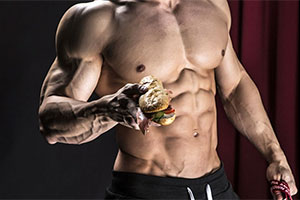After a two year hiatus, I’ve started bench pressing again.
Really, I have no business benching. My shoulders are shot and I’ve always had a love hate relationship with this particular exercise.
I’ve always had a really good bench for my size (Love), and the bench has punished me for this on numerous occasions (Hate…really, really strong hate).
Despite these facts, about a month ago I bought Jim Wendler’s 5/3/1 e-book and was inspired to maybe give the bench press one more chance.
In order to do my absolute best to keep myself functioning during this little fling, I have committed to see my Osteopath when ever I have any shoulder/neck issues.
Why an Osteo? Well she’s a message therapist/Osteo and I’ve had good luck with her in the past.
Now this post has nothing to do with the bench press or osteopathy…but it was a good lead into my story.
This morning I was at my Osteo’s office. She happens to share an office with a Naturopath (stop me if you’ve heard this one before).
As I was paying my bill the Naturopath came out of her office with her patient. As the patient was checking out the Naturopath instructed her to hold her arm straight out in front of her.
The Naturopath then held various bottles to the woman’s chest while simultaneously pushing down on her outstretched arm.
Apparently this is called ‘muscle testing’. The theory is that this one simple diagnostic can tell you how your body reacts to different things.
‘bad’ things will make you noticeably and instantly weaker, while ‘good’ things will make you instantly stronger (In this case something called ‘arnica’ made her stronger, while her cell-phone made her ‘off the charts’ weaker).
This is the description I found at goodhealthinfo.net:
fundamental to traditional Chinese medicine, muscle testing is a noninvasive way of evaluating the body’s imbalances and assessing its needs. It involves testing the body’s responses when applying slight pressure to a large muscle, to provide information on energy blockages, the functioning of the organs, nutritional deficiencies, and food sensitivities, among other things. It can also be used to test the body’s responses to herbs and other remedies.
Now, I have no problems with ‘fringe’ ideas. Admittedly I’m a skeptic at heart, but I consider myself a rare form of skeptic – I’m an optimistic skeptic – I REALLY would love for these things to work, but I beleive they need to be properly tested (and the skeptic in me doubts many things are able to pass proper testing).
With muscle testing, I want to see evidence of repetition and reproducibility. Meaning it should be tested multiple times and have similar measurable results each time.
So here is a quick study that any masters student could/can do.
1. Set up a force transducer (a device that measures force) along a length of chain.
2. Have your subjects stretch their arm in front of them while holding the length of chain.
3. Take a baseline measurement of how much force it takes to lower your subjects arm while they are resisting. (they’re trying to keep their arm parallel to the ground, you are pulling their arm down while measuring the amount of force you are using)
4. (only for science geeks ==> use this number to set your acceptable range then conduct your power analysis to figure out how many subjects/measurements you will need)
5. Place random objects in individual black bags (Arnica Montana, Aspartame, Echinacea, ginseng, creatine, a cell-phone, some Lego blocks and rat poison)
6. While both the investigator and subject are blinded to what is in the bag, place the bag against the subjects chest as you ask them to resist as you pull their arm down.
7. Measure the force recorded by the force transducer.
8. Repeat this with the same subject on different days while giving the items in a different random order each time. Allow for a seven day period in between tests.
If the ‘bad’ things consistently and repeatedly cause a decrease in the force that the subjects can generate, while the ‘good’ things cause either an increase or no change in force, then I am all for muscle testing. And, I am completely open to the idea of using this as a diagnostic test.
However, until these tests are conducted, analyzed, peer reviewed and published, I think it can be potentially dangerous and misleading to use easily testable diagnositcs in medicine before they have been proven valid (and ESPECIALLY after they have been proven invalid on multiple occasions).
Proper measurement is a founding principle of science, when professionals are giving advice it is important that they ignore what they ‘want to work’ (the optimist in them) and concentrate on what has been proven to work (satisfying their inner skeptic)
BP








